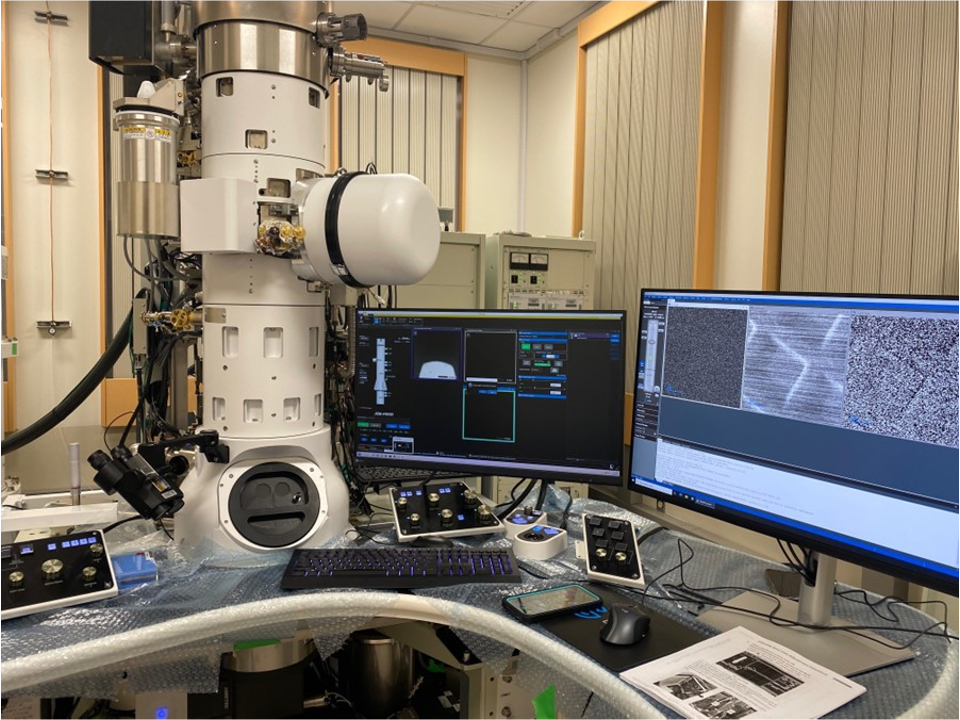Below are the descriptions and specifications for new instruments at our facility. Some have been installed and are operational, while others are currently being installed or expected to arrive at a later date. Please dont hesitate to reach out if you have specific questions. The fee structure will be announced in the few weeks.
Transmission Electron Microscope, JEOL JEM-F200 S/TEM (Installation in progress)
 A 200 kV Field Emission Scanning Transmission Electron Microscope offering atomic-level imaging, elemental and chemical analysis via EDS, EELS, and EFTEM.
A 200 kV Field Emission Scanning Transmission Electron Microscope offering atomic-level imaging, elemental and chemical analysis via EDS, EELS, and EFTEM.
RPI’s F200 STEM is configured with a high-brightness 8x108 A/cm2sr (at 200kV) cold field emitter with energy resolution under 0.3eV. The microscope features 0.16nm imaging resolution in dark field STEM mode and probe size down to 0.14 nm. It is equipped with Jeol large area (100 mm2) silicon drift Energy Dispersive X-ray (EDS) detector for high-speed compositional analysis. The F200 also features Gatan Image Filter GIF 1065 Continuum ER System for chemical and elemental analysis via electron energy loss spectroscopy (EELS) and energy filtered EFTEM, with spectra and mapping modes. 4DSTEM and magnetic samples imaging is available.
The F200 is fully optimized for in situ work utilizing the available set of specialty holders for temperature, gas, liquid and biasing studies. The microscope’s upgraded pumping system is designed to sustain the in situ work. The Gatan ClearView 1195 camera (16MP) provides 1600 fps ultra-fast image capturing and supports in situ and 4DSTEM applications.
Contact: Dr. Katharine Dovidenko (dovidk2@rpi.edu)
Electron Beam Lithography System, RAITH EBPG5200 Plus (Arrival in August 2025)
The EBPG 52000 Plus is a direct write, maskless electron beam lithography tool that enables high-precision patterning (<10 nm) on resist-coated substrates while supporting rapid design iteration. It operates at 50 or 100 keV with beam currents from 50 pA to 350 nA. The system includes a 1 mm field size, 125 MHz pattern generator, and automatic aperture changer, with an overlay accuracy of ≤ 5 nm and stitching of ≤ 8 nm. The system includes a Z-Lift stage for handling thick or curved substrates and a high-efficiency secondary electron detector for enhanced imaging. It is equipped with top-referenced wafer holders for 100 mm, 150 mm, and 200 mm wafers, along with a standard 6" mask holder suitable for both piece parts and system calibration. A 10-holder airlock enables loading multiple samples with a single pumpdown, and a dedicated storage rack is provided for organizing holders when not in use.
Additional features include an alignment microscope with X/Y stage and Z measurement for pre-alignment, an uninterruptible power supply, magnetic field cancellation system, temperature-controlled enclosure, and active anti-vibration platform. The system includes GenISys BEAMER software for data preparation and Proximity Effect Correction (PEC), which fractures designs into simple shapes, heals overlaps, and compensates for resist overexposure from backscattered electrons. BEAMER software also optimizes stitching, fracturing, and field ordering for improved patterning efficiency.
Contact: Kent Way (wayk2@rpi.edu)
AJA Multichamber Deposition System (Arrival in July 2025)
The AJA Multichamber Deposition System features two interconnected thin film deposition chambers—an ATC-2200 sputtering chamber and an ATC-1800-E evaporation chamber—linked via a common load-lock and magnetic sample transfer mechanism. This design allows substrates up to 8” in diameter to move between chambers without breaking vacuum. The ATC-2200 chamber includes four A340-UHV magnetron sputtering sources with 4" targets, in-situ tilt gimbals, reactive gas injection, and pneumatic shutters. It supports multiple power supplies (two 1500 W DC, one pulsed DC, two RF, and one HiPIMS) and includes a 1200 l/s Pfeiffer turbopump, an air-cooled 21 cfm Roots pump, and a substrate heater up to 800°C. Gas lines include: Ar (100 SCCM), N₂ and O₂ (20 SCCM each), one Ar line to a sputter source, and two reactive gas lines to the substrate distributor.
The ATC-1800-E evaporation chamber offers both thermal and e-beam evaporation, utilizing a UHV linear e-beam source with six pockets (four compatible with in-situ crucible exchange), and a thermal evaporation source. It includes an Inficon SQC310 quartz crystal deposition controller and is cryo pumped. The shared load-lock, positioned between the two chambers, uses a Pfeiffer 80 l/s turbopump and the same 21 cfm Roots pump. It features a 6-position cassette elevator with removable cassettes, enabling substrate transfer via a magnetic arm and custom susceptors.
Contact: Kent Way (wayk2@rpi.edu)
Deep Reactive Ion Etching System, SAMCO RIE-800iPB (Installation in Progress)
The SAMCO DRIE System RIE-800iPB is a deep reactive ion etching (DRIE) tool that supports both Bosch and non-Bosch processes for etching silicon and other materials. It can achieve etch rates over 50 microns per minute with aspect ratios exceeding 100:1, making it suitable for high-aspect-ratio features in MEMS devices, TSVs, and plasma dicing. It accommodates wafers up to 8” using an electrostatic chuck. In the Bosch process, SF6 plasma performs isotropic etching followed by C4F8 deposition of a protective layer, cycling rapidly (0.1-second switching) to minimize scalloping. Both process types are fully supported.
The tool includes three RF power supplies: a 5kW 13.56 MHz ICP power supply, a 1kW 13.56 MHz bias power supply with pulsing capability, and a 400 kHz low-frequency substrate bias power supply, all with automatic matching. MFC-controlled gas lines for SF6, C4F8, Ar, high-flow O2, and low-flow O2 are included. The vacuum system consists of a 2200 L/s turbomolecular pump backed by a 500 L/min dry pump, and a separate 1500 L/min dry pump for the load lock. The entire pumping circuit and chamber sidewalls are heated to reduce polymer buildup. Additional features include optical emission spectroscopy for endpoint detection and auto stage height control.
Contact: Kent Way (wayk2@rpi.edu)
